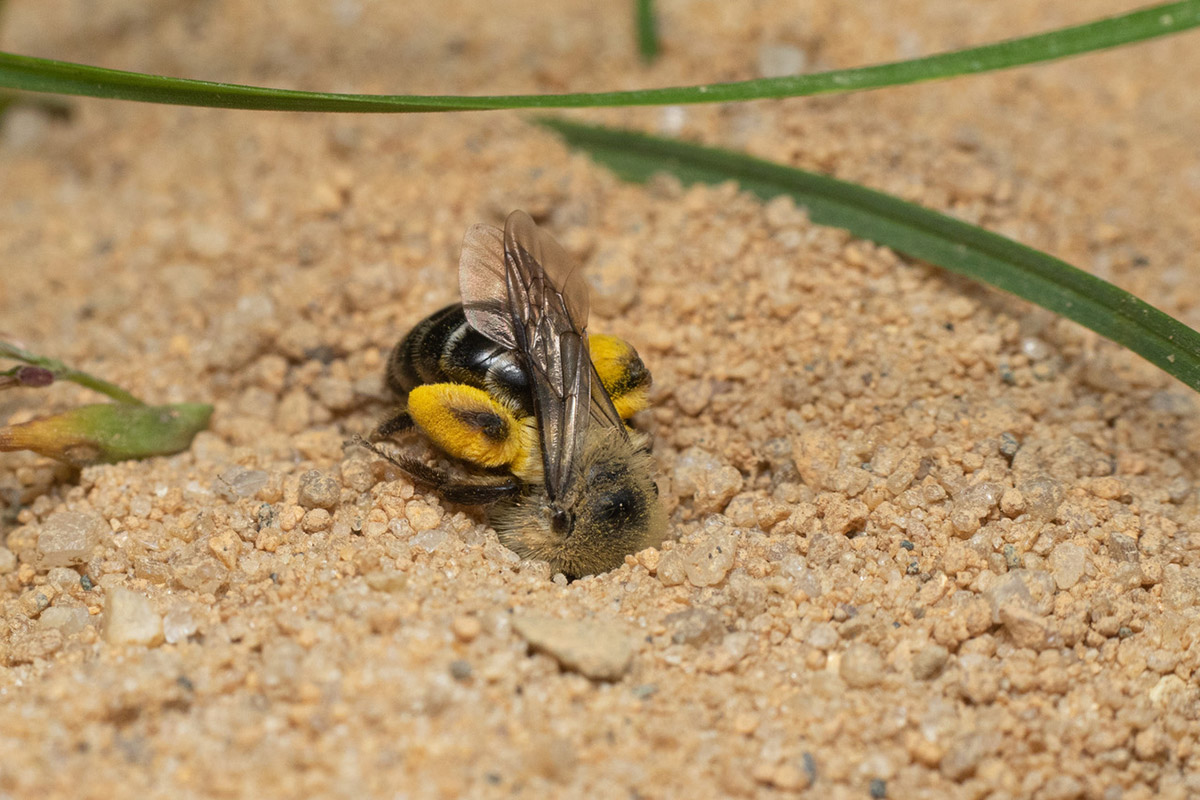You may think of bees as born flyers, not diggers. However, many species of bees spend a good chunk of their lives underground. To navigate a subterranean world, these bees have evolved to be talented excavators.
There are a few different reasons a bee might need to dig; if you spot a bee digging in the soil, take a moment to watch to see what it’s up to!
Nest building
Many species of solitary bees, including sweat bees, cellophane bees, digger bees, and miner bees, nest in the ground. Each female constructs her own nest site herself by digging a tunnel in the soil.
Some bees create shallow burrows less than 4 inches under the soil. Other bees dig tunnels several feet under the ground. In Utah, the Haynes’s mining bee (Andrena haynesi) has been observed nesting 9 feet under the ground. That’s a lot of digging!
Most bees (like the aster mining bee, pictured below) prefer dry, well drained soils to nest in. You might spot ground-nesting bees in your garden, along roadside blanks, or in particularly sandy areas.

Getting ready for the winter
As the weather starts to get cooler, you might observe large bumble bees crawling on the ground or digging in the soil. These are queen bumble bees, looking for a place to spend the winter.
Unlike solitary bees, which rear their young on their own, bumble bees live in small colonies with many workers and a single queen. Most of the bees in the colony do not survive the winter: only the new queens, born in the fall or late summer, will live till the next year.
Though bumble bees are social insects, bumble bee queens overwinter by themselves. Once a queen has found a good spot with loose, dry soil, she will dig a shallow den. She will spend the next 3 to 9 months hibernating, emerging from the soil only once the weather has warmed up.
There's a lot we still don't understand about the habitat needs of overwintering bumble bees. If you happen to spot a queen digging or searching for a place to overwinter, please submit your observation to Queen Quest, an effort by Xerces and other collaborators to collect anecdotal observations of overwintering queens.
Video: Genevieve Pugesek
Parasites
Though digging is a normal behavior for healthy bees, digging can also indicate that a bee is very, very sick.
Infections by parasitic nematodes can cause bumble bee queens to spend a lot of time digging. Nematodes generally infect queens in the winter, during hibernation. When an infected queen emerges from her overwintering site, she will spend the remainder of her life clumsily digging shallow burrows in the soil, spreading immature nematodes through her feces. These parasites can be a big problem for bumble bee populations: in some regions, more than a quarter of spring bumble bee queens may be infected by nematodes.
Conopid flies are another parasite of bumble bees which can cause unusual digging behaviors. Conopid flies attack worker bees and drones as they forage on flowers. If successful, the fly will lay an egg between the body segments of the bee. Once the egg hatches, it will start to feed on the bee’s insides, eventually inducing the bee to bury itself alive in the soil. RIP, worker bee!
Learn more
If you would like to learn more about the underground lives of bees, you are welcome to attend our online webinar “In the Life of Bees: Nesting in the Darkness” on October 19, 2023.
Further reading:
- Where do pollinators go during the winter?
- Where do bumble bee queens overwinter?
- Remember the ground nesting bees when you make your patch of land pollinator-friendly



